This was published 1 year ago
What happens when you turn junk into art? It’s suddenly worth stealing
In the lead-up to an exhibition by Tennant Creek Brio artists, some of their upcycled artworks went missing. They’re willing to discuss a ransom.
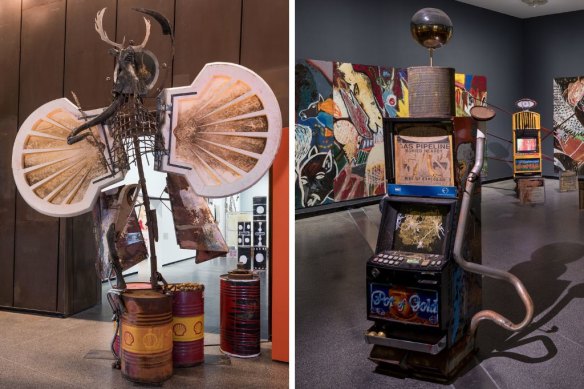
Credit: Andrew Curtis
Artists have been repurposing found objects for decades: Picasso incorporated old newspapers and other ephemera into his work, Damien Hirst used refuse for his assemblages, and Marcel Duchamp famously had his urinal. But the works created by Tennant Creek Brio, many of which are currently showing at the Australian Centre for Contemporary Art, represent much more than mere upcycling.
The art collective’s members live and work on Warumungu Country in and around the Barkly regional town of Tennant Creek in the Northern Territory, and use salvaged materials that have been left behind on their country – behind pubs, at abandoned roadhouses, on the side of roads and former mines – which they “reinscribe” with their First Nations experiences and cultural identities.
Repurposing the detritus is an act of healing and resistance for Tennant Creek Brio; their work explores themes of reclamation.

Rupert Betheras with a collaborative work from the Australian Centre for Contemporary Art survey.Credit: Justin McManus
The collective was founded in 2016 when the artists – whose key members are Fabian Brown Japaljarri, Lindsay Nelson Jakamarra, Rupert Betheras, Joseph Williams Jungarayi, Clifford Thompson Japaljarri, Jimmy Frank Jupurrurla, Fabian Rankine Jampijinpa and Marcus Camphoo Kemarre – began working together in an outreach program run by Betheras, a Melbourne artist and former AFL Collingwood player. What began as an outlet for healing and therapy at the local men’s centre has bloomed into a full-time, widely acclaimed art practice.
These days, members come from five northern and Central Desert language groups (Warlpiri, Alyawarr, Warlmunpa, Kaytetye and Warumungu), alongside non-Indigenous members, and in less than a decade, they have all become successful artists, with works featured in major institutions. The ACCA show, Tennant Creek Brio: Juparnta Ngattu Minjinypa Iconocrisis, is the first major survey of their work, and its title uses Warumungu, Warlpiri and English. The Warumungu “Juparnta Ngattu” refers to ceremonial strength through image-making, and the Warlpiri term, “Minjinypa”, means “cheeky one” or “trouble(maker)”.
There’s a punk playfulness to Tennant Creek Brio’s work, even as it reflects the region’s history of colonial violence and displacement of Indigenous people.
Among the repurposed oil barrels, car bonnets, satellites and solar panels, the disconnect between the Indigenous and European experience is most overt in the group’s poker machine works. Salvaged from a Tennant Creek’s former Shaft nightclub, the machines have been painted and gutted, one of them pierced through with traditional spears.
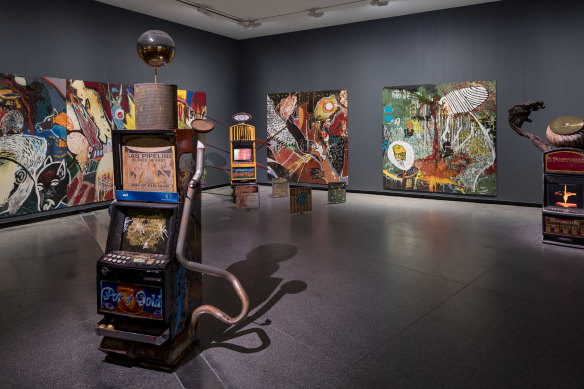
Repurposed poker machines at the ACCA show.Credit: Andrew Curtis
Of the seven machines brought to Melbourne from the NT, four were stolen from storage in West Melbourne ahead of the show’s opening. Wrapped up and locked away in a local metalworker’s warehouse, it’s thought they went missing on the Labour Day long weekend when an illegal rave was held nearby.
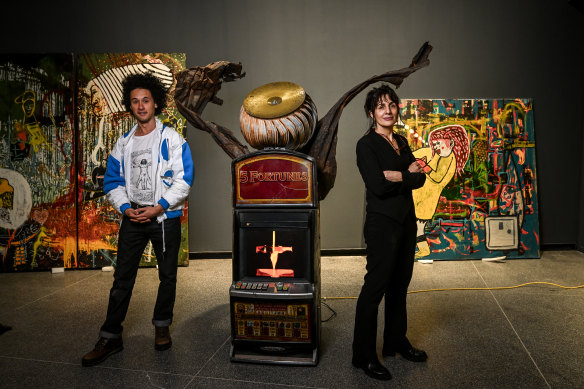
Levi McLean and curatorial adviser Dr Erica Izett with one of the poker machine artworks.Credit: Justin McManus
“It’s hard to understand the motive of someone who wants four of these,” says Brio member Levi McLean. “It wouldn’t have been easy to remove them – they’re heavy. And you couldn’t resell them.”
Jimmy Frank Jupurrurla, a senior Warumungu cultural leader whose practice centres on contemporary sculpture and carving cultural objects, incorporated a mulga log carved into multiple spears in one of the poker machine works.
“The reason why I made the spear with the sculpture, and one with a spear through the poker machine, is about white people who bring in alcohol and gambling and all those other things that make us weak,” Jupurrula says. “That’s what that poker machine represents.”
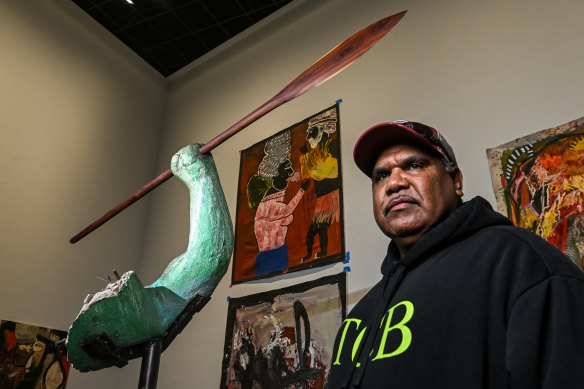
Jimmy Frank Jupurrula with a spear incorporated into the fist of an Incredible Hulk sculpture.Credit: Justin McManus
While he works on his spear in a warehouse in South Melbourne in the lead-up to the show’s opening, he explains that Tennant Creek Brio’s practice is partly about saying “we’re still here”.
“We always try to tell our story mixing the traditional and the new way, so we use mining materials that have been left on our country, to say, ‘clean up your rubbish’, while also using it in a political and artistic way, to say you know, this is ... wrong.”
Jupurrula’s “punishment spear” is incorporated into the fist of a discarded arm from a sculpture of the Incredible Hulk, which was once a feature at a now abandoned roadhouse.
In the South Melbourne warehouse, the artists are also sorting out dozens of repurposed maps discarded by mining companies. The exhibition, explains co-curator and ACCA artistic director Max Delany, features an entire room of these topographical maps, which were left behind when the Tennant Creek Peko copper-gold mine and the Warrego mine, about 50 kilometres from Tennant Creek, were abandoned.
The maps, Delany says, represent an intersection of the European worldview and Indigenous culture. “These maps are a European way to see the landscape, through geology, topography and borders, but these guys have, of course, their own songlines, their own stories, their own narratives that pre-exist those. So in a way, they’re reasserting their cultural markings on that country.”
One large-scale sculpture uses signage from an abandoned Shell petrol station to create wings for an imposing four-metre high junkyard angel.
UAP: Unidentified (Ab)original Phenomenon, says McLean, is a “kind of petrochemical effigy”. McLean, who joined the collective in 2019, worked on the initial concept for sculptor Jonathan Leahey.
“Like many Brio artworks, it has the quality of a chimera, a wild beast mixed with the human,” he says. “I thought it important that the angel capture the duality of human nature and attempt to overcome or ascend this duality.”
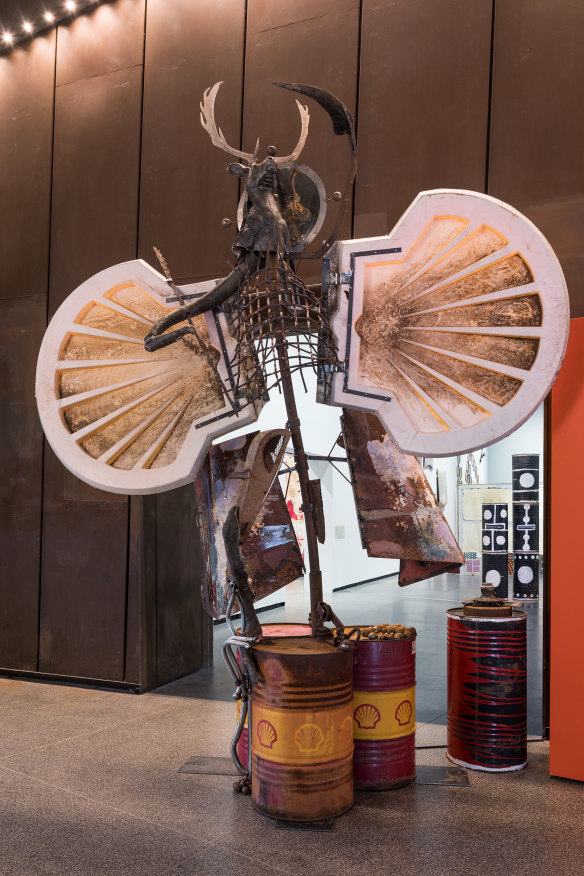
Tennant Creek Brio’s junkyard angel, UAP: Unidentified (Ab)original Phenomenon.Credit: Andrew Curtis
The Archangel Michael was a reference, McLean explains. “At the base of the sculpture, there is a large hand grasping the archangel as if to bring them down into the depths,” he says. “In the industrial heaviness of this exhibition, these barrels are like the tunnel of a mine, which is not incidental.”
The sculpture features a head made from a plastic kangaroo and the petrified horns of a feral deer, a combination which, like most of Tennant Creek Brio’s work, mixes the Indigenous and the European.
With the show now installed, Brio members can only speculate on what became of those missing poker machines.
“Maybe they’re in someone’s man cave?” McLean says. “Maybe someone has them as a shrine to the casino? Either way, we’d love for whoever took them to make contact. And we’re willing to negotiate the ransom!”
Tennant Creek Brio: Juparnta Ngattu Minjinypa Iconocrisis is at the Australian Centre for Contemporary Art until November 17.